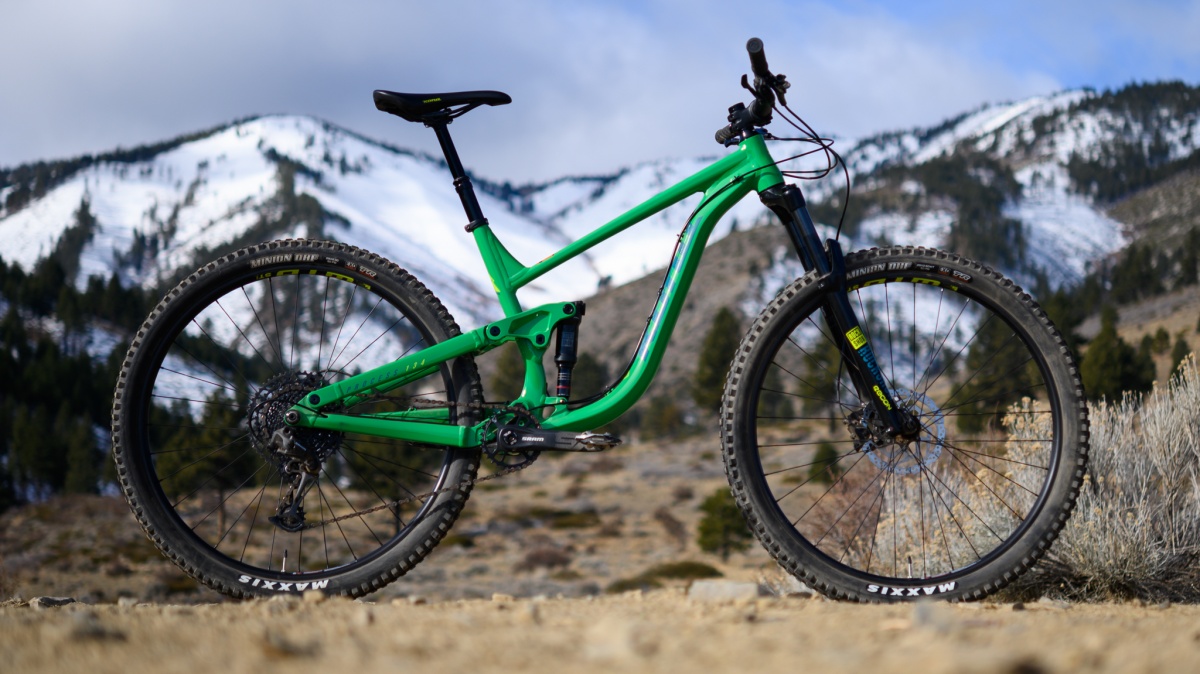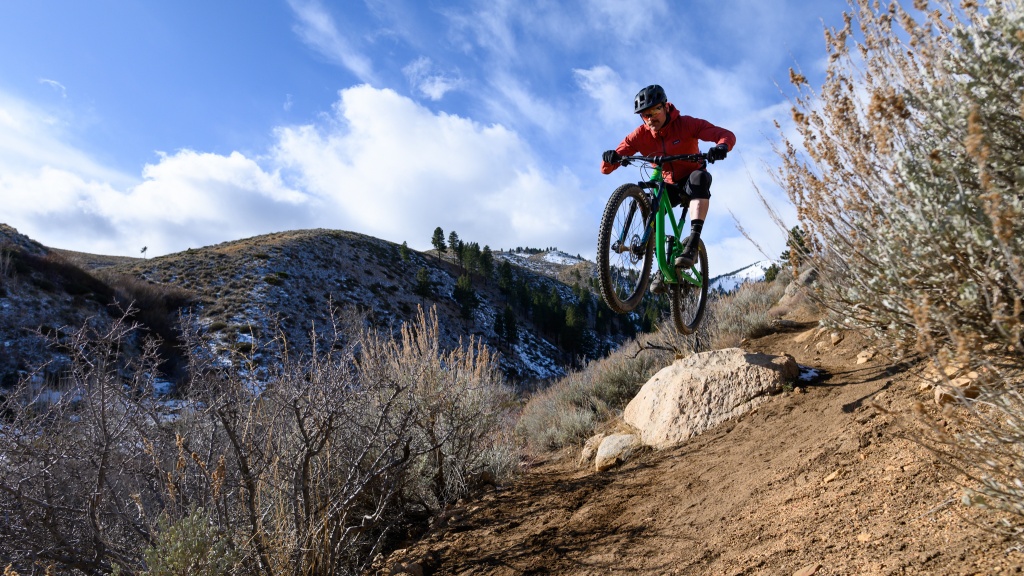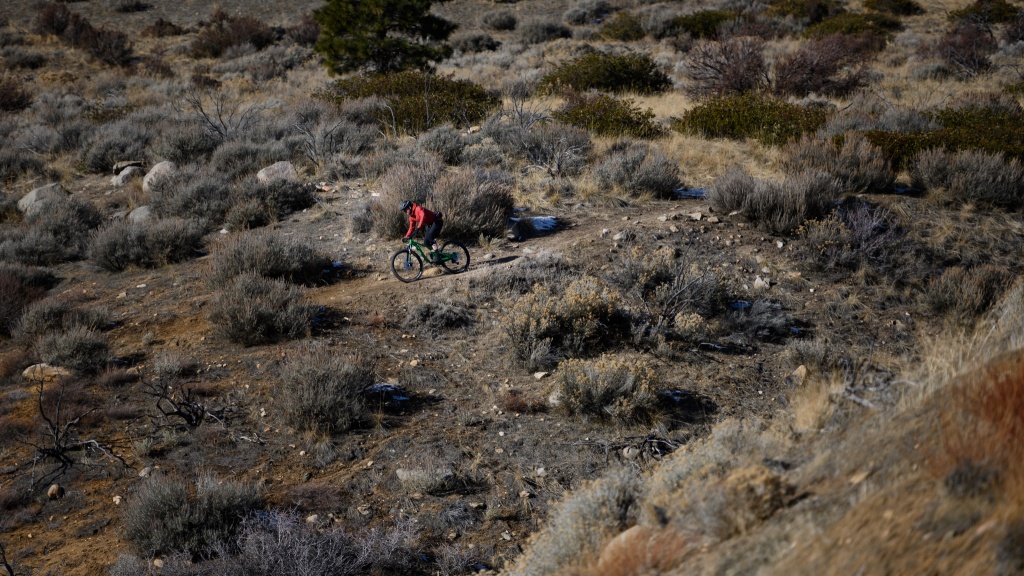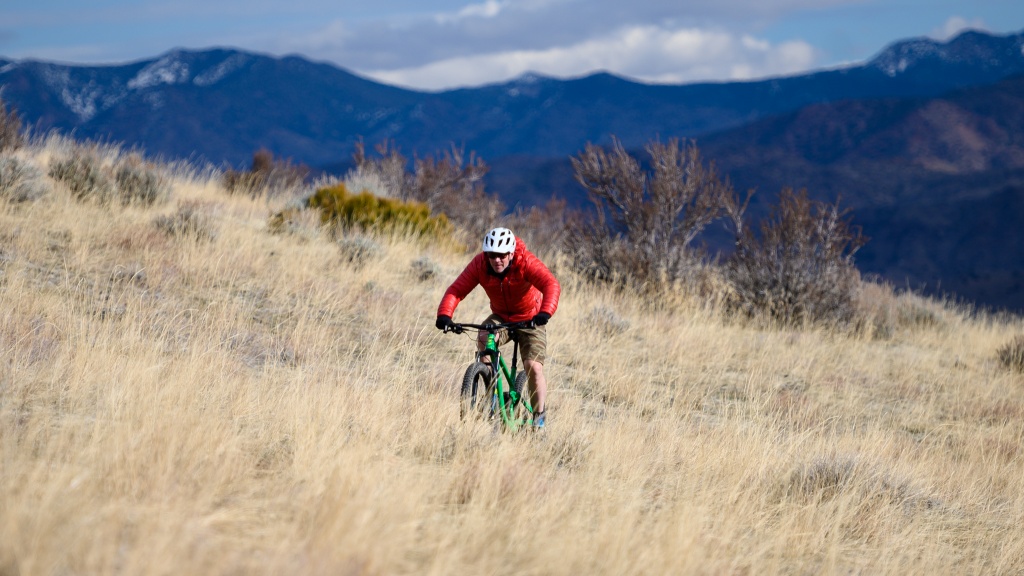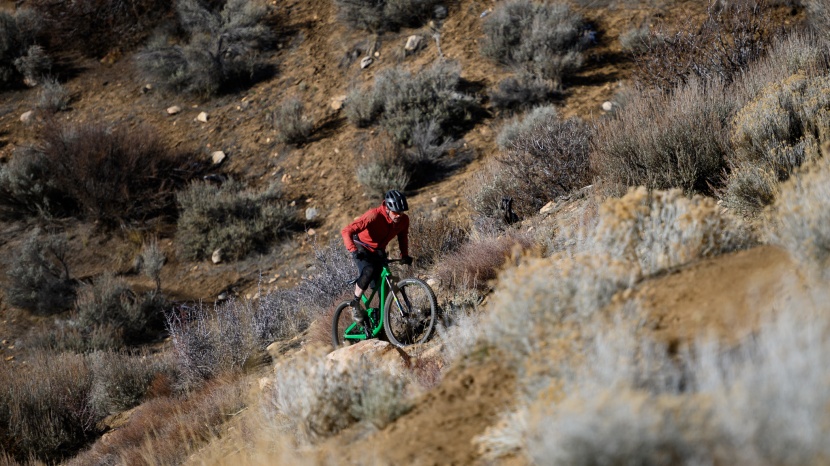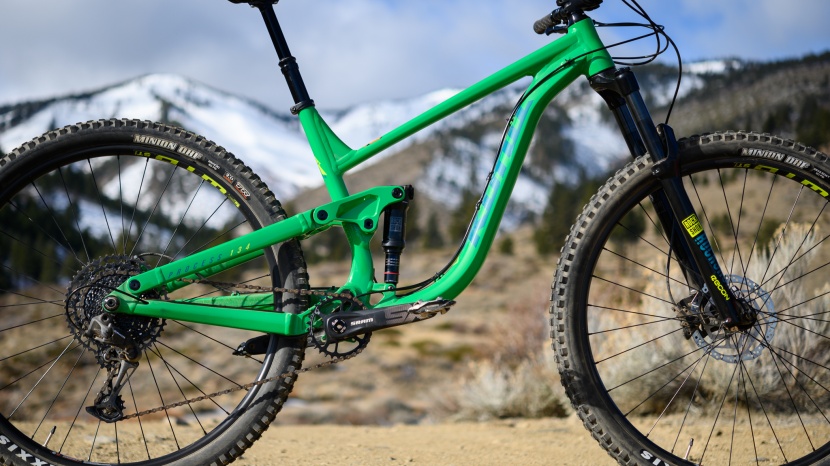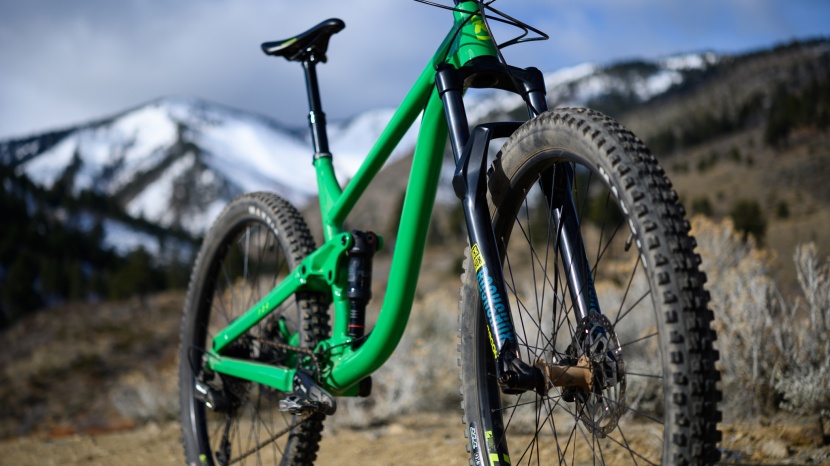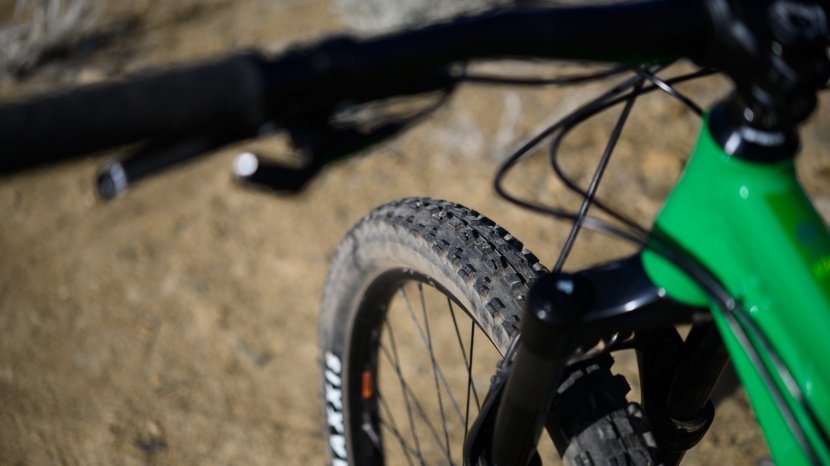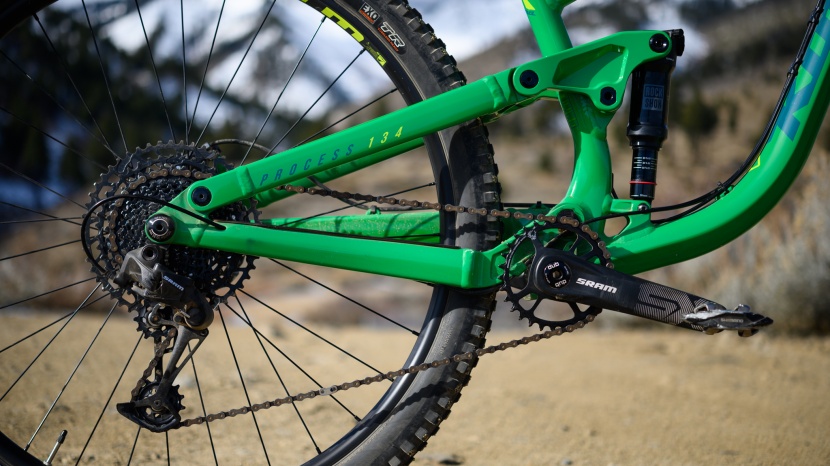Kona Process 134 29 Review
Our Verdict
Our Analysis and Test Results
Should I Buy This Bike?
The Process 134 29 absolutely crushes the descents and is fun to ride on everything from mellow rolling terrain to aggressive and chunky rock gardens. Testers were blown away by how capable and confidence-inspiring this bike was when pointed downhill. Sure, it's a bit heavy, and it is far from the best climbing bike of the bunch, but riders who prioritize downhill performance are sure to love this mid-travel shredder. The geometry is the primary reason this bike rips so hard, and the terms modern and progressive are certainly appropriate to describe it. The Process 134 is long and slack, but Kona has managed to make a versatile performer that rides well regardless of speed or steepness of pitch. Don't get this bike if you want to race your friends up the hill. Do get this bike if you want to try to beat them back down…
Fun Factor
Judging from the smiles and stoke at the bottom of descents, it was obvious that our testers had loads of fun while riding the Process 134 29. Testers found this bike to be one of their favorites on the descents, especially for opening up the throttle and charging hard. Kona nailed the geometry, and this mid-travel ripper provides a confident and capable downhill performance that rivals that of bikes that cost twice as much. This bike was the most fun when pushing the envelope of speed and terrain, though it worked well at a range of speeds and trail types. The cockpit setup and beefy tire specification did wonders to make this bike more capable and fun to ride downhill.
The downhill prowess of the Process 134 29 is definitely its highlight, climbing on it was a little less fun than some of the competition. This is primarily due to its noticeably heavier weight that gives this bike a sluggish feel. That said, if you're not racing anyone up the hill, this bike will transport you comfortably and reliably back to the top to blast more downhills. Despite its less impressive climbing performance, we still gave the Process 134 high marks for its fun factor due to its downhill capabilities that far exceed its pay grade.
Downhill Performance
It came as little surprise to our testers that the Process 134 29 is a confident and capable descender. Just looking at the geometry numbers, beefy tire specification, and dialed cockpit setup, it was clear that this bike is meant to charge downhill. Kona's bikes generally tend to feel a bit biased towards the descents, and the new Process 134 fits that description. Sure, it's a versatile mid-travel trail bike, but it rips the descents as well or better than any other bike in this price range.
This bike's modern progressive geometry is totally dialed and this bike is capable and competent with just enough travel to tackle virtually any terrain. The 66-degree head tube angle is pretty slack for a mid-travel trail bike and is one of the primary reasons this bike feels confident and composed in steeper terrain. The 1215mm wheelbase and generous 470mm reach also help to keep the rider centered in a comfortable position between the wheels that doesn't require much fore-aft body movement. This allows the rider to relax as they focus on shredding whatever comes down the trail. Despite having a relatively long wheelbase, Kona has managed to squeeze shorter 427mm long chainstays on the rear end of this bike which helps to keep it a little bit snappy and playful considering its overall length and weight. One of the biggest gripes our testers had with the Process 134 29 was its weight. Our size Large test bike weighed in at 34 lbs and 13 oz set up tubeless and without pedals. This is the heaviest bike in this test and one of the heaviest trail bikes we've tested in the past couple of years. Interestingly, despite the heavier weight, it was still a tester favorite on the descents. At slower speeds, the weight was more noticeable as the handling could feel a bit sluggish. Once up to medium and high speeds, however, this weight faded into the background and it felt stable and planted and ripped through corners.
Kona's Beamer suspension design works well and the rear end of this bike feels nice and plush. Small bump compliance is excellent and it handles high-frequency chop with remarkable composure for a bike in this price range. Big hits also feel good, and despite one of our testers pushing the ring off the bottom of the rear shock's stanchion more than once, he didn't note any harsh bottom outs. While the Recon fork can feel a little flimsy in super rough terrain, testers were quite impressed with its plushness and it felt relatively well balanced with the rear suspension. That said, some harder impacts would quickly remind you that you're riding a budget fork.
Kona did a good job outfitting this budget-friendly model with components that largely enhance its downhill performance. They nailed several important aspects of the build including the wheels and tires. The wheels are tubeless-ready with modern 30mm internal width that pairs well with the meaty Maxxis Minion DHF tires. Our testers are huge DHF fans and they give this bike a ready for anything look and feel and excellent, predictable, cornering traction. The Process 134 29 also comes with a proper length dropper seatpost, 170mm on the size large we tested, which was appreciated by our taller testers, especially when diving into more aggressive terrain as this bike likes to do. The short stout stem and 780mm wide handlebar with a 35mm clamp diameter combine to make a sturdy and comfortable front end with precise steering and plenty of leverage for controlling this bike.
Climbing Performance
The Process 134 29 is a competent climber but its far from the best in its class. It has a comfortable seated position and appropriate geometry like a steep seat tube angle, but its heavier weight and lack of a compression damping switch on the rear shock are quite noticeable on the uphills. You can absolutely ride up just about anything on this bike, it just feels a bit sluggish and inefficient compared to some.
The weight of the Process 134 29 becomes apparent the moment you point this bike uphill and start pedaling. At 34 lbs and 13 oz, its the heaviest in the test and you absolutely notice it, especially when compared to bikes that weigh around 3 lbs less. This is by no means a fatal flaw, and you will get used to it, but those who prioritize riding uphill fast may be turned off by the weight. Another factor that comes in to play on this bike is the lack of a compression damping or climbing switch on the rear shock. Our testers found this to be a strange omission. While seating and pedaling there isn't much suspension movement and it feels relatively efficient, out of the saddle efforts result in significant bobbing of the rear suspension, however, causing the bike to feel lethargic when you go to sprint up short climbs. A mellower seated approach feels best when climbing on this bike. We feel that a rear shock with compression damping would greatly improve this bike's climbing performance, especially on long fire road grinds. Again, this is tolerable but one of the reasons this bike is outperformed on the climbs. That said, the active rear suspension provides excellent traction as the rear wheel feels glued to the ground.
The geometry is generally quite comfortable on the climbs. The generous reach never made our testers feel cramped. The steep 76.3-degree seat tube is in line with modern standards and helps give the rider a somewhat upright seated position and lines you pretty directly above the cranks for efficient transfer of power. The 76.3-degree seat tube measurement is an effective seat tube angle, however, and our taller testers noted that it didn't feel quite that steep with the seat raised up higher. The 1215mm wheelbase is one of the longest in this review. It doesn't feel too long necessarily, although a little skill and a calculated approach go a long way in technical terrain and sharp switchbacks. Pedal strikes were generally a non-issue with the 342mm bottom bracket height, though the usual care should still be taken to avoid them. The SRAM SX Eagle drivetrain offers a huge gear range and we found it to be relatively trouble-free on the Process. The Maxxis Minion DHF isn't our first choice for a rear tire, but it still provides relatively good climbing traction in most conditions.
Build
The Process 134 29 is built around a 6061 Aluminum frame with 134mm of rear-wheel travel and a 140mm fork. The rear-wheel travel is handled with Kona's Beamer suspension platform which is a linkage driven single pivot design. Mountain bike component technology continues to trickle down and the 134 is equipped with a budget-oriented but perfectly functional component specification.
Suspension components are typically one of the weak points on budget-minded builds, but they have come a long way in recent years. While far from flashy, the RockShox Recon RL fork on the Process 134 is a huge step up in performance over Recon forks from just a few years ago. No, it can't match the performance of sturdier higher-end forks, but it is relatively supple and has an adjustable air spring, rebound adjustment, and a compression damping knob that acts like a lockout. The trunnion-mounted RockShox Deluxe Select shock worked very well during testing, though it only has a rebound adjustment.
Kona hit the mark when they chose the wheels and tires for the Process 134 29. The wheels are comprised of Shimano hubs and WTB ST i30 TCS rims which are tubeless-ready with a 30mm internal rim width. The Maxxis Minion DHF tires are also tubeless ready with the EXO casing and a 2.5" WT in the front and a 2.3" in the rear. This tire spec is excellent and perfectly matched for the capabilities of the 134, plus it ensures that you won't need to pony up for new tires right off the bat.
The cockpit setup on the Process 134 is also quite dialed and in line with this bike's trail slaying intentions. Kona used a handful of house-branded components including the 35mm clamp 780mm wide handlebar and 50mm stem. They also spec'd a proper 170mm length (on our size Large test bike) TranzX dropper seatpost with a 1x style remote lever. The Kona Trail saddle is reminiscent of a WTB Volt and is quite comfortable for long days on the bike.
Twelve-speed drivetrains have also recently made their way onto bikes in this price range, and the Process 134 comes with SRAM SX Eagle. While this drivetrain setup can be finicky, we experienced no issues with it on this particular test bike. The 30-tooth chainring pairs with the 11-50-tooth cassette to provide ample range for any pitch of climb. The brakes are the same Shimano MT200 hydraulic disc brakes found on many of the other bikes in this review, and while they work ok, they are a bit underpowered and the long-throw levers feel a little cheap.
Value
At its retail price, the Process 134 29 falls at the upper end of the price spectrum for the models in this test. We feel this is a solid value, as this bike is a hard-charging trail bike with performance that far exceeds the asking price. This is an excellent entry-level option for the rider who prioritizes the descents and isn't especially concerned with weight.
Conclusion
Any rider on a budget or just getting into the sport who is looking for a confident and super-capable descender should give the Process 134 29 a look. This bike rips downhill with authority thanks to its modern geometry and the dialed aspects of its build. It's far from the lightest weight or the fastest climber, but our testers found it easy to look past those flaws with its impressive downhill performance. We'd happily recommend this bike to anyone who wants to charge hard and doesn't mind pushing around a little extra weight.


